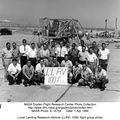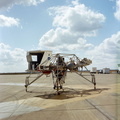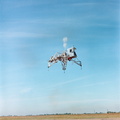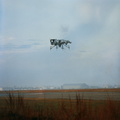
WIKIARCHIVES.SPACE
The Human Spaceflight Archive

Information
- Taken in
- Edwards Air Force Base
- Author
- NASA
- Description
- (1965) In this 1965 NASA Flight Research Center photograph the Lunar Landing Research Vehicle (LLRV) is shown at near maximum altitude over the south base at Edwards Air Force Base. Built of tubular aluminum like a giant four-legged bedstead, the vehicle was to simulate a lunar landing profile from around 1500 feet to the moon's surface. To do this, the LLRV had a General Electric CF- 700-2V turbofan engine mounted vertically in gimbals, with 4200 pounds of thrust. The engine, using JP-4 fuel, got the vehicle up to the test altitude and was then throttled back to support five-sixths of the vehicle's weight, simulating the reduced gravity of the moon. Two hydrogen-peroxide lift rockets with thrust that could be varied from 100 to 500 pounds handled the LLRV's rate of descent and horizontal translations. Sixteen smaller hydrogen-peroxide rockets, mounted in pairs, gave the pilot control in pitch, yaw, and roll. On the LLRV, in case of jet engine failure, six 500-pounds-of thrust rockets could be used by the pilot to carefully apply lift thrust during the rapid descent to hopefully achieve a controllable landing. The pilot's platform extended forward between two legs while an electronics platform, similarly located, extended rearward. The pilot had a zero-zero ejection seat that would lift him away to safety. Weight and balance design constraints were among the most challenging to meet for all phases of the program (design, development, operations).
- Created on
- Albums
- US SPACE PROGRAM / APOLLO / COMPONENTS / LLTV/LLRV
- Source link
- https://www.flickr.com/photos/nasacommons/16305922268/in/album-72157650733490842/
- Visits
- 141
- Rating score
- no rate
- Rate this photo
- License
- Public Domain
- Modified by WikiArchives
- No (original)
- Downloads
- 0
EXIF Metadata
- DateTimeOriginal
- 1965:00:00 00:00:00
Powered by Piwigo













